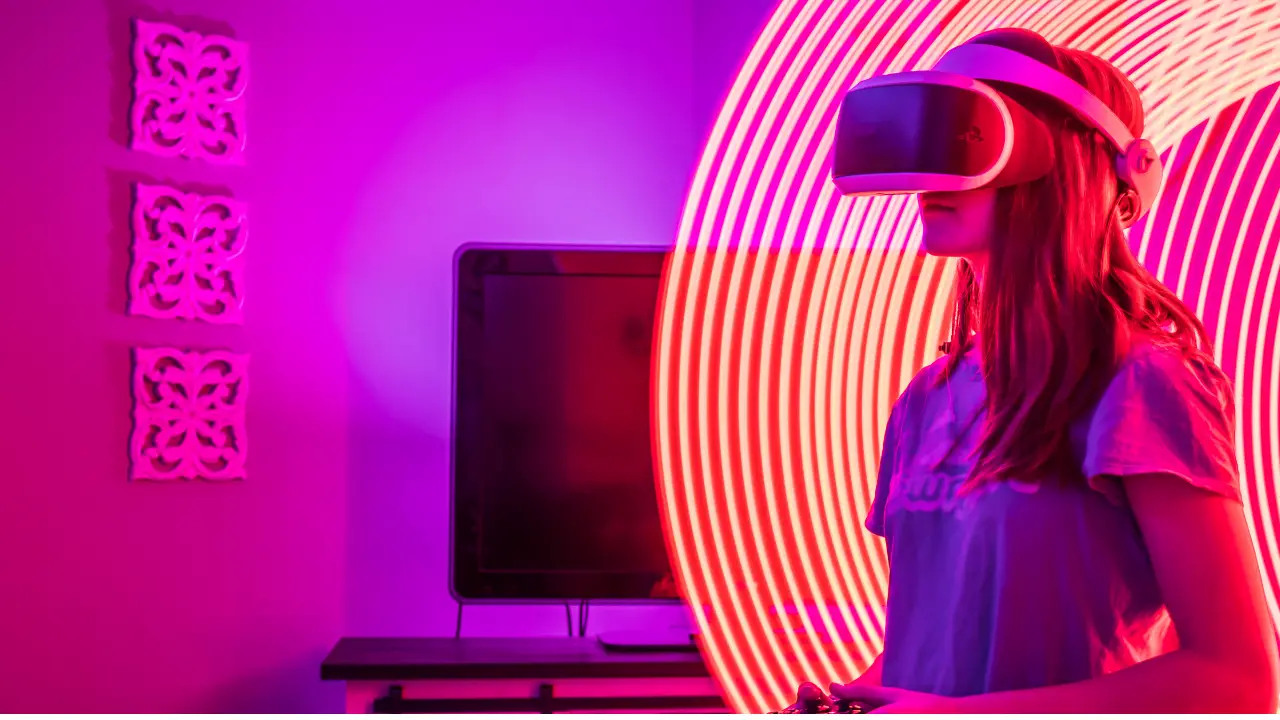
Virtual Reality: The Future Unfolds
Outline for the Article on “Virtual Reality”
-
Introduction to Virtual Reality
- Defining Virtual Reality
- The Evolution of Virtual Reality Technology
-
Technological Foundations of VR
- Key Components of VR Systems
- The Science Behind VR
-
Virtual Reality in Gaming
- The Rise of VR Gaming
- Popular VR Games and Experiences
-
VR in Education and Training
- VR Applications in Education
- Simulation Training in Various Industries
-
Virtual Reality in Healthcare
- VR for Medical Training
- Therapeutic Uses of VR
-
Business and Virtual Reality
- VR in Retail and Real Estate
- Corporate Training and VR
-
The Social Aspect of VR
- Virtual Social Spaces
- VR and Global Connectivity
-
Virtual Reality and the Arts
- VR in Filmmaking and Art
- Immersive Art Experiences with VR
-
Challenges and Limitations of VR
- Technical Challenges
- Ethical and Psychological Considerations
-
The Future of Virtual Reality
- Emerging Trends in VR
- Predictions for VR’s Future Development
-
Accessibility in Virtual Reality
- Making VR More Accessible
- Overcoming Accessibility Barriers in VR
-
Environmental Impact of VR
- VR and Sustainable Practices
- Reducing Environmental Footprint with VR
-
Innovations in VR Hardware
- Advances in VR Headsets
- Future of VR Hardware Technology
-
Virtual Reality in Entertainment Beyond Gaming
- VR in Theme Parks and Attractions
- VR in Music and Live Events
-
Integrating AI with Virtual Reality
- AI-driven VR Experiences
- The Role of AI in Enhancing VR
-
VR’s Role in Remote Work and Collaboration
- VR for Remote Teams
- Collaborative Tools in VR
-
Legal and Privacy Concerns in VR
- Data Privacy in VR
- Navigating Legal Issues in VR Environments
-
Economic Impact of Virtual Reality
- VR’s Contribution to the Economy
- Job Opportunities in the VR Industry
-
Virtual Reality in Marketing and Advertising
- Innovative Marketing with VR
- Engaging Customers Through VR
-
User Experience and Interface Design in VR
- Designing Intuitive VR Interfaces
- Enhancing User Experience with VR
-
Cultural and Global Impact of VR
- VR’s Influence on Global Culture
- Bridging Cultural Gaps with VR
-
Security Challenges in Virtual Reality
- Ensuring Security in VR
- Addressing Cybersecurity Threats in VR
-
VR in Public Services and Government
- VR for Public Safety Training
- VR in Urban Planning and Development
-
Conclusion: Embracing the Virtual World
- Summarizing VR’s Current State
- The Future Role of VR in Society
SEO Meta-Description:
Explore the fascinating world of Virtual Reality (VR), its impact on various sectors, and the future it holds. Dive into the VR revolution today!
Virtual Reality
Virtual Reality (VR) is a rapidly evolving technology with the potential to revolutionize how we interact with digital environments. In this section, we delve into what VR is and trace its historical development, highlighting how it has become a significant part of today’s tech landscape.
The Concept of Virtual Reality
Here, we define VR and discuss its core principles, including the immersive experience it offers and how it differs from traditional media.
Virtual reality (VR) is a technology that simulates a realistic sensory experience, often involving sight, sound, and sometimes touch, in a computer-generated environment. The goal of VR is to immerse users in a simulated world that feels as lifelike as possible, typically achieved through the use of specialized hardware such as headsets and controllers.
The concept of VR has been around for decades, with early experiments dating back to the 1960s. However, it’s only in recent years that VR technology has become advanced enough to provide truly immersive experiences accessible to consumers.
Key components of a virtual reality system include:
- Headset: A VR headset is worn over the eyes like a pair of goggles and contains displays that show the virtual environment to the user. These displays are typically high-resolution screens that offer a wide field of view to create a sense of immersion.
- Tracking System: VR systems often use sensors or cameras to track the movements of the user’s head and sometimes their hands and body. This tracking data is then used to update the virtual environment in real time, allowing users to look around and interact with objects as they would in the real world.
- Input Devices: To interact with the virtual environment, users typically use handheld controllers or gloves equipped with sensors. These devices allow users to manipulate objects, move around, and perform actions within the virtual space.
- Software: VR experiences are created using specialized software tools and development kits. This software allows developers to design and program virtual environments and create interactive elements and immersive audio-visual effects.
VR technology has applications across various industries, including gaming, entertainment, education, healthcare, and training. In gaming, VR offers players a more immersive and realistic experience, allowing them to feel like they’re truly inside the game world. In healthcare, VR is used for simulations and training exercises, allowing medical professionals to practice procedures in a safe and controlled environment.
As VR technology continues to advance, with improvements in display resolution, tracking accuracy, and motion-sensing capabilities, it’s likely to become an increasingly integral part of our digital lives, offering new ways to work, play, and communicate in virtual spaces.
Historical Evolution of VR
This subsection will explore the timeline of VR’s development, from its early conceptualizations to the advanced systems available today.
The concept of virtual reality (VR) has roots that trace back to the early 20th century, but the modern development of VR technology can be divided into several key historical milestones:
- Early Concepts (19th to mid-20th century):
- The idea of immersive experiences beyond reality can be seen in literature, such as Stanley G. Weinbaum’s short story “Pygmalion’s Spectacles” (1935), which describes a device that lets users experience fictional worlds through holographic images.
- In the 1950s and 1960s, pioneers like Morton Heilig conceptualized and prototyped devices such as the Sensorama (1962), a mechanical simulator featuring 3D video, stereo sound, vibration, and even smells, aiming to immerse viewers in a multisensory experience.
- Early VR Research (1960s to 1980s):
- The 1960s saw significant advancements in computer graphics and simulation technologies, leading to experiments in creating immersive environments for military training and academic research.
- Ivan Sutherland’s “Sword of Damocles” (1968) is considered one of the earliest VR head-mounted displays (HMDs), though it was highly cumbersome and lacked the graphics and tracking capabilities of modern VR.
- Commercialization Attempts (1980s to 1990s):
- The 1980s and 1990s saw attempts to commercialize VR technology, with companies like VPL Research, founded by Jaron Lanier, introducing early VR systems such as the DataGlove and the EyePhone.
- Consumer interest in VR grew with arcade games like Virtuality (1991), which offered multiplayer VR experiences, and the release of consumer-grade VR headsets like the Sega VR (1993). However, these early attempts were hindered by technical limitations, high costs, and limited content.
- Resurgence and Modern Era (2000s to present):
- The 2000s saw a resurgence of interest in VR, driven by advancements in computing power, display technology, and motion tracking.
- The launch of the Oculus Rift Kickstarter campaign in 2012 by Palmer Luckey reignited excitement around VR, leading to increased investment and development in the field.
- The release of consumer-grade VR headsets like the Oculus Rift, HTC Vive, and PlayStation VR in the mid-2010s brought VR to mainstream audiences, with a focus on gaming and entertainment.
- Continued advancements in VR hardware, software, and content creation have expanded its applications beyond gaming to fields such as education, healthcare, architecture, and training.
Today, VR continues to evolve with innovations like standalone headsets, hand tracking, and social VR experiences, paving the way for new possibilities in immersive computing and human-computer interaction.
Technological Foundations of VR
The advancement of VR technology is pivotal in its growing adoption. We will explore the technology that makes VR possible and the latest innovations in the field.
Key Technologies Behind VR
This part will cover the essential technologies that power VR, such as head-mounted displays, motion tracking, and graphical rendering.
Innovations in VR Hardware
We will discuss the latest developments in VR hardware, including advancements in haptic feedback and display resolution, which are enhancing the VR experience.
Virtual Reality in Gaming
VR has significantly impacted the gaming industry, offering new levels of immersion and interaction.
Evolution of VR Gaming
This subsection will trace the growth of VR gaming, from its initial introduction to the gaming world to its current state.
Current Trends and Popular VR Games
Here, we’ll highlight the latest trends in VR gaming and some of the most popular VR games that have captivated audiences.
VR in Education and Training
Virtual Reality is not just for entertainment; it’s also a powerful tool in education and training.
VR for Skill Development
We will explore how VR is being used to develop skills in various fields, providing hands-on experience in a controlled environment.
Case Studies in Educational VR
This part will present real-world examples of how VR is being implemented in educational settings, showcasing its effectiveness and versatility.
Virtual Reality in Healthcare
The application of VR in healthcare is showing promising results, from treatment to training.
Therapeutic Uses of VR
This subsection will discuss how VR is used in therapy, including for mental health treatment and physical rehabilitation.
VR in Medical Training and Surgery
We will explore the use of VR in medical training and surgery, highlighting its role in enhancing precision and understanding in complex medical procedures.
The Business of Virtual Reality
VR also makes waves in the business sector, offering new ways to engage with customers and visualize products.
VR in Marketing and Retail
Here, we’ll discuss how VR is being used in marketing and retail to create immersive brand experiences and product demonstrations.
VR in Real Estate and Architecture
This subsection will cover the application of VR in real estate and architecture, allowing for virtual property tours and architectural visualizations.
Social Impacts of Virtual Reality
The social implications of VR are vast, affecting how we connect with others and raising new ethical questions.
VR and Social Connection
We will discuss how VR is creating new forms of social interaction, enabling people to connect in virtual spaces in ways not possible before.
Ethical Considerations in VR
This part will address the ethical challenges with VR, such as privacy concerns and the potential for misuse.
Virtual Reality in Arts and Entertainment
VR is transforming the arts and entertainment industry, offering new mediums for creative expression.
VR in Film and Music
Here, we’ll explore how VR is being used in film and music, creating immersive cinematic and musical experiences.
Immersive Art Experiences
This subsection will discuss how artists are using VR to create immersive art installations and experiences, pushing the boundaries of traditional art forms.
Future Directions in VR Technology
The future of VR technology is filled with exciting possibilities and potential breakthroughs.
Emerging Technologies in VR
We will look at emerging technologies in the VR space, such as mixed reality and advanced sensory feedback systems.
Predictions for VR’s Future
This part will offer predictions on where VR technology might be headed and how it could further integrate into our daily lives.
Challenges and Limitations of VR
Despite its potential, VR faces several challenges and limitations that need to be addressed.
Technical Challenges
Here, we’ll discuss the technical hurdles that VR technology faces, such as latency issues and the need for more powerful processing capabilities.
Accessibility and Inclusivity Issues
This subsection will address the challenges in making VR accessible to a wider audience, including affordability and designing for diverse user needs.
VR and Environmental Sustainability
The environmental impact of VR technology is an important consideration as it becomes more widespread.
VR’s Carbon Footprint
We will examine the carbon footprint associated with VR technology, from the manufacturing of VR headsets to their energy consumption.
Sustainable Practices in VR Development
This part will discuss how sustainability can be integrated into the development and production of VR technologies.
User Experience in Virtual Reality
Creating a positive and engaging user experience is crucial for the success of VR applications.
Designing for User Comfort
Here, we’ll talk about the importance of user comfort in VR design, addressing issues like motion sickness and user interface design.
Creating Engaging VR Experiences
This subsection will focus on how to create VR experiences that are not only immersive but also engaging and appealing to users.
Augmented Reality vs. Virtual Reality
Augmented Reality (AR) and VR are often mentioned together, but they offer different experiences.
Differences and Similarities
We’ll compare AR and VR, highlighting their differences and how they complement each other in various applications.
Complementary Technologies
This part will discuss how AR and VR can be used together to create hybrid experiences, combining the best of both worlds.
VR in Remote Work and Collaboration
With the rise of remote work, VR offers new possibilities for virtual collaboration and meetings.
VR for Virtual Meetings
Here, we’ll explore how VR is being used for remote work, including virtual meetings and conferences.
Collaborative Projects in VR
This subsection will discuss how VR technology is facilitating collaboration on projects, allowing teams to work together in virtual environments.
Legal and Privacy Concerns in VR
As VR technology becomes more prevalent, it’s imperative to address the legal and privacy concerns that arise within these virtual spaces.
Data Privacy in VR
This subsection will discuss the importance of data privacy in VR environments, examining how personal data is collected, stored, and used in VR, and the measures needed to protect user privacy.
Navigating Legal Issues in VR Environments
We’ll delve into the legal complexities unique to VR, including intellectual property rights, user-generated content, and the enforcement of laws within virtual worlds.
Economic Impact of Virtual Reality
The VR industry is not only a technological marvel but also a significant economic driver with its broad range of applications.
VR’s Contribution to the Economy
Here, we’ll analyze how VR is contributing to global economies, focusing on its influence in sectors like gaming, education, healthcare, and real estate.
Job Opportunities in the VR Industry
This section will highlight the burgeoning job market within the VR industry, detailing various career paths and skill sets in demand, from VR content creation to hardware engineering.
Virtual Reality in Marketing and Advertising
VR offers innovative ways for brands to engage with consumers, redefining the landscape of marketing and advertising.
Innovative Marketing with VR
We’ll explore how companies are utilizing VR to create immersive and interactive marketing campaigns that offer unique and memorable consumer experiences.
Engaging Customers Through VR
This subsection will focus on the strategies and techniques used in VR to captivate and engage customers, enhancing brand loyalty and driving sales.
User Experience and Interface Design in VR
User experience (UX) and interface design are crucial in making VR accessible, intuitive, and enjoyable.
Designing Intuitive VR Interfaces
Here, we’ll discuss the principles of effective VR interface design, focusing on how to create user-friendly and navigable VR environments.
Enhancing User Experience with VR
We’ll explore the various ways VR developers are enhancing user experience, from reducing motion sickness to creating more immersive and interactive scenarios.
Cultural and Global Impact of VR
VR technology is not just reshaping industries; it’s also influencing cultures and societies worldwide.
VR’s Influence on Global Culture
This section will delve into how VR is affecting global culture, examining its role in art, entertainment, and social interaction across different cultures.
Bridging Cultural Gaps with VR
We’ll discuss how VR is being used as a tool to bridge cultural gaps, offering immersive experiences that promote understanding and empathy among diverse groups.
Security Challenges in Virtual Reality
Ensuring security in VR environments is paramount to protect users and maintain trust in the technology.
Ensuring Security in VR
This subsection will address the security challenges in VR, exploring potential vulnerabilities and the measures being taken to secure VR platforms against threats.
Addressing Cybersecurity Threats in VR
We’ll discuss the emerging cybersecurity threats specific to VR and the strategies being employed to combat these risks, ensuring a safe and secure VR experience.
VR in Public Services and Government
VR’s potential extends to public services and government operations, offering new ways to serve the public and improve processes.
VR for Public Safety Training
Here, we’ll explore how VR is used in public safety training, providing realistic and safe training environments for emergency responders and law enforcement.
VR in Urban Planning and Development
We’ll examine the role of VR in urban planning and development, showcasing how it’s used to visualize and plan urban projects, engage the public, and make more informed decisions.
Embracing the Virtual World
In conclusion, Virtual Reality is much more than just a technological novelty; it’s a transformative medium with the potential to reshape numerous aspects of our lives.
Summarizing VR’s Current State
This section will provide a summary of the current state of VR, highlighting its achievements and the impact it has already made across various sectors.
The Future Role of VR in Society
We’ll offer insights into the future role of VR in society, predicting how it will continue to evolve and influence our daily lives, industries, and global interactions.
FAQs:
-
What are the basic requirements for a VR setup?
A basic VR setup typically requires a VR headset, compatible hardware (like a PC or gaming console), and VR software or applications. Some systems may also require external sensors or controllers.
-
Can VR be used for educational purposes?
Yes, VR is increasingly used in education to provide immersive learning experiences, simulate real-world scenarios, and enhance student engagement in various subjects.
-
Is VR technology accessible to people with disabilities?
Answer: While VR technology poses certain challenges, efforts are being made to make VR more accessible through adaptive hardware, software modifications, and inclusive design practices.
-
What are the potential health impacts of using VR?
While VR technology poses certain challenges, efforts are being made to make VR more accessible through adaptive hardware, software modifications, and inclusive design practices.
-
How is VR being used in healthcare?
VR in healthcare is used for medical training, surgical simulation, patient therapy, and rehabilitation, offering
-
What is the future of VR technology?
The future of VR includes advancements in hardware, more realistic and immersive experiences, wider accessibility, and expanded applications in various industries.
External Link:
Discover the Shocking Ways Virtual Reality (VR) Will Transform Your Life and Gaming Experience
Conclusion: Virtual Reality stands as a beacon of technological advancement, with its ever-expanding applications promising to revolutionize how we interact, learn, work, and entertain ourselves. As we embrace this virtual world, the potential for innovation and connection seems boundless, ushering in a new era of immersive experiences.





